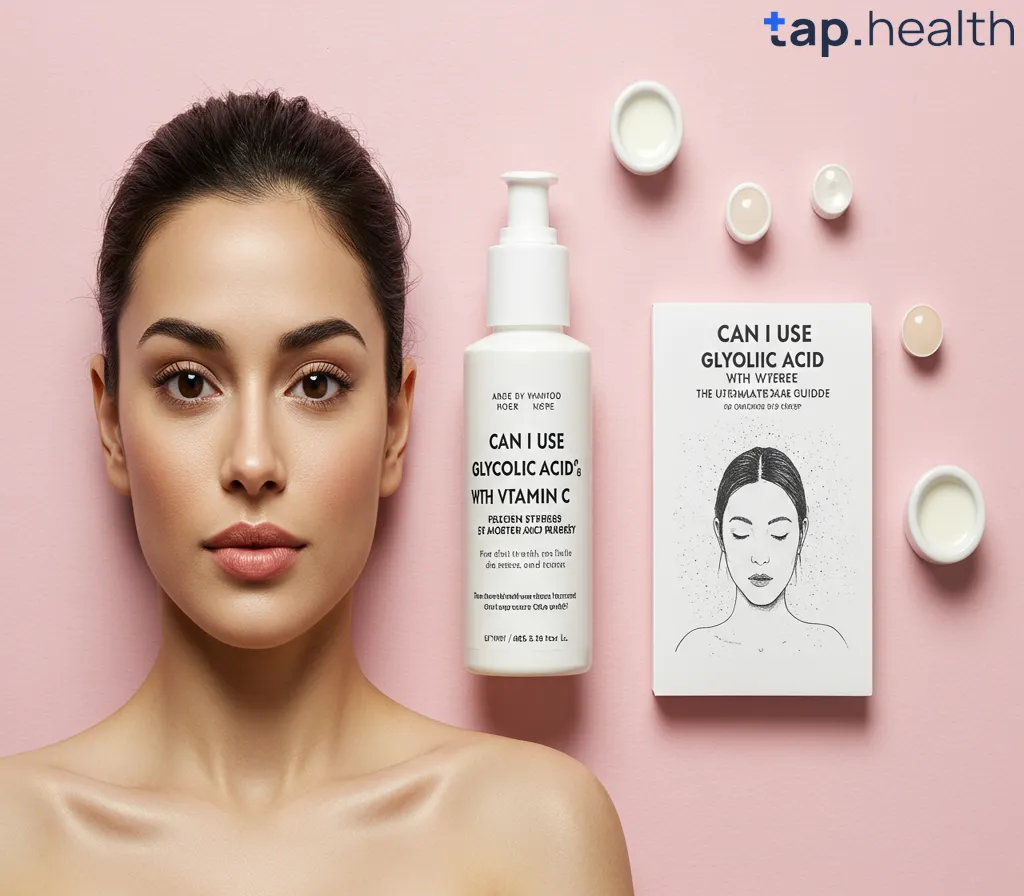If you’re into skincare, you’ve probably heard about glycolic acid and vitamin C. They’re two of the most talked-about ingredients for brighter, smoother, younger-looking skin.
But here’s the big question:
Can I use glycolic acid with vitamin C?
Maybe you’ve tried one and loved it. Now you’re wondering—can I use both? Will they work better together? Or will they wreck my skin?
The short answer: Yes, you can use glycolic acid and vitamin C together—but you have to be smart about it.
Used the wrong way, they can cause redness, dryness, or irritation. But when layered correctly, they can give you glowing, even-toned skin that looks healthy and fresh.
In this guide, we’ll break it all down in simple, easy-to-understand language—no confusing science terms, no jargon. Just real, practical advice based on dermatologist recommendations and trusted health sources like the American Academy of Dermatology (AAD), Mayo Clinic, Cleveland Clinic, and the Journal of Clinical and Aesthetic Dermatology.
We’ll cover:
- What glycolic acid and vitamin C do for your skin
- Whether they’re safe to use together
- The best order to apply them
- How often you should use them
- Who should avoid combining them
- And answers to all the top questions people search online
Let’s get into it.
What Is Glycolic Acid?
Glycolic acid is a type of alpha hydroxy acid (AHA). It comes from sugar cane and is one of the most popular exfoliants in skincare.
It works by gently removing dead skin cells from the surface of your skin. This helps:
- Unclog pores
- Fade dark spots and acne scars
- Smooth rough texture
- Brighten dull skin
- Reduce fine lines and wrinkles
Because glycolic acid has small molecules, it can go deep into the skin—making it very effective, but also more likely to cause irritation if overused.
You’ll find glycolic acid in:
- Cleansers
- Toners
- Serums
- Moisturizers
- Peels (at-home or professional)
Most over-the-counter products contain 5–10% glycolic acid. Higher strengths (20–70%) are used in chemical peels by dermatologists.
What Is Vitamin C in Skincare?
Vitamin C (also called L-ascorbic acid) is a powerful antioxidant that protects your skin from damage.
It helps:
- Brighten skin and reduce dark spots
- Boost collagen production (which keeps skin firm)
- Protect against pollution and UV damage
- Fade acne scars and sun spots
- Improve overall skin tone
Unlike glycolic acid, vitamin C doesn’t exfoliate. Instead, it fights free radicals (harmful molecules from sun, smoke, and stress) and helps repair skin damage.
You’ll find vitamin C in:
- Serums (most common)
- Moisturizers
- Face masks
- Powders (mixed with water or serum)
It’s best used in the morning, since it helps protect your skin during the day.
Can I Use Glycolic Acid With Vitamin C?
Yes—you can use glycolic acid and vitamin C together, but not always at the same time.
Both are powerful ingredients. When used correctly, they can give you amazing results. But if you use them too often or layer them wrong, they can irritate your skin.
Here’s why:
- Both lower the skin’s pH (make it more acidic)
- Both can cause dryness or sensitivity
- Using them together may increase the chance of redness, peeling, or stinging
So, the real question isn’t can you use them together—but how to use them safely.
Let’s break it down.
Do Glycolic Acid and Vitamin C Cancel Each Other Out?
Some people worry that using glycolic acid and vitamin C together will make them less effective.
But here’s the truth: They don’t cancel each other out.
In fact, they can complement each other.
- Glycolic acid removes dead skin cells, making it easier for other products (like vitamin C) to sink in.
- Vitamin C calms inflammation and protects skin after exfoliation.
So, instead of fighting, they actually help each other work better—if you use them the right way.
Can You Mix Glycolic Acid and Vitamin C in the Same Routine?
Yes—but with caution.
You can use both in the same routine, but not in the same step.
Here’s how to do it safely:
H3: Option 1 – Use Them at Different Times of Day
This is the safest and most popular method.
- Morning: Use vitamin C
Why? It protects your skin from sun damage and pollution during the day. - Night: Use glycolic acid
Why? Your skin repairs itself at night, and AHAs work best when you’re not exposed to sunlight.
This way, you get the benefits of both without overwhelming your skin.
Option 2 – Use Them on Alternate Days
If your skin is sensitive, try:
- Day 1: Vitamin C in the morning
- Day 2: Glycolic acid at night
- Day 3: Repeat
This gives your skin time to recover and reduces the risk of irritation.
Option 3 – Layer Them Carefully (Advanced)
If you want to use both in the same day, you can—but only if your skin is strong and not sensitive.
Here’s how:
- Cleanse your face
- Apply glycolic acid first (it exfoliates and preps the skin)
- Wait 15–20 minutes
- Apply vitamin C
- Follow with moisturizer and sunscreen (in the morning)
Warning: This method can be harsh. Only try it if you’ve used both ingredients separately for weeks without issues.
Never layer them if your skin is red, peeling, or irritated.
What’s the Best Order to Apply Glycolic Acid and Vitamin C?
Order matters.
If you’re using both in the same routine, glycolic acid should go first.
Why?
- Glycolic acid exfoliates and removes the top layer of dead skin.
- This clears the way for vitamin C to sink deeper and work better.
So the correct order is:
- Cleanser
- Glycolic acid (toner or serum)
- Wait 15–20 minutes
- Vitamin C serum
- Moisturizer
- Sunscreen (in the morning)
Never apply vitamin C first and then glycolic acid. That can cause stinging and reduce effectiveness.
Can Using Glycolic Acid and Vitamin C Cause Irritation?
Yes—especially if you:
- Use them too often
- Use high-strength formulas
- Have sensitive skin
- Don’t moisturize enough
- Skip sunscreen
Common signs of irritation:
- Redness
- Dryness
- Flaking
- Burning or stinging
- Tight or itchy skin
If you notice any of these, stop using one (or both) and give your skin a break.
How Often Should I Use Glycolic Acid and Vitamin C?
Less is often more.
Here’s a safe schedule for most skin types:
Glycolic Acid:
- Beginners: 1–2 times per week
- Experienced users: Up to 3–4 times per week
- Never use daily unless your skin is very strong and you’re under dermatologist care
Overuse can damage your skin barrier, making it dry and sensitive.
Vitamin C:
- Daily use is fine for most people
- Start every other day if your skin is sensitive
- Once your skin adjusts, you can use it every morning
You can use vitamin C more often than glycolic acid because it’s less harsh.
Who Should Avoid Using Glycolic Acid and Vitamin C Together?
Some people should be extra careful—or avoid combining them altogether.
People with Sensitive Skin
If your skin stings easily, turns red, or gets dry, you’re likely sensitive.
Instead of using both, pick one and stick to it.
Or use them on alternate days with a gentle moisturizer.
People with Rosacea or Eczema
Glycolic acid can make rosacea worse. Vitamin C (especially in high concentrations) may also irritate inflamed skin.
Talk to your dermatologist before using either.
People with Dry or Mature Skin
Older skin is often drier and thinner. Too much exfoliation can cause flaking and irritation.
Use glycolic acid less often (once a week) and always follow with a rich moisturizer.
People Using Retinoids or Other Acne Medications
If you’re using prescription acne treatments (like tretinoin, benzoyl peroxide, or salicylic acid), adding glycolic acid and vitamin C can be too much.
Your skin may become over-exfoliated and damaged.
Stick to one active at a time, or space them out.
Does Glycolic Acid Affect Vitamin C’s Stability?
This is a common concern.
Vitamin C is unstable—it can break down when exposed to light, air, or changes in pH.
Glycolic acid lowers the skin’s pH, which could, in theory, affect vitamin C.
But in real life, this isn’t a big problem—especially if you:
- Wait 15–20 minutes after glycolic acid before applying vitamin C
- Use a stable vitamin C formula (look for L-ascorbic acid with ferulic acid and vitamin E)
- Store your vitamin C in a dark, airtight bottle
Most dermatologists agree: the pH shift from glycolic acid doesn’t ruin vitamin C if you layer them properly.
Can You Use Glycolic Acid and Vitamin C for Acne?
Yes—both can help with acne, but in different ways.
Glycolic Acid for Acne
- Exfoliates pores to prevent clogging
- Reduces blackheads and whiteheads
- Fades acne scars and dark marks
- Improves skin texture
Great for mild to moderate acne.
Vitamin C for Acne
- Fights inflammation (reduces red, angry pimples)
- Fades post-acne marks (dark spots left behind)
- Strengthens skin barrier
- Antioxidant protection
Doesn’t treat active breakouts but helps with healing and scarring.
Used together, they can give clearer, smoother skin over time.
Just go slow—acne-prone skin is often sensitive.
Can Glycolic Acid and Vitamin C Help With Dark Spots?
Absolutely.
Both are skin brighteners that help fade dark spots, sun spots, and acne scars.
How Glycolic Acid Fades Dark Spots
- Speeds up cell turnover
- Removes pigmented dead skin cells
- Allows new, even-toned skin to surface
Results appear in 4–8 weeks with regular use.
How Vitamin C Fades Dark Spots
- Blocks melanin production (the pigment that causes dark spots)
- Lightens existing spots
- Prevents new ones from forming
Works best when used daily over several weeks.
Used together, they’re a powerful combo for hyperpigmentation.
What’s the Best Routine for Using Glycolic Acid and Vitamin C?
Here’s a simple, safe routine you can follow.
Morning Routine:
- Cleanse with a gentle face wash
- Apply vitamin C serum (let it absorb for 1–2 minutes)
- Moisturize
- Apply sunscreen (SPF 30 or higher) – non-negotiable
Skip glycolic acid in the morning—it makes your skin more sensitive to the sun.
Night Routine:
- Cleanse (double cleanse if you wear makeup)
- Apply glycolic acid (toner, serum, or peel—start 1–2x/week)
- Wait 15–20 minutes
- Apply vitamin C (optional) – only if your skin is used to both
- Moisturize with a rich cream
- Use a face oil (optional) for extra hydration
Tip: If you’re new to either ingredient, use them separately for 2–4 weeks before combining.
Can You Use Glycolic Acid and Vitamin C With Other Actives?
It depends.
Some ingredients mix well. Others don’t.
Safe to Combine With
- Hyaluronic acid: Adds hydration and reduces dryness
- Niacinamide: Calms skin and reduces redness
- Ceramides: Repair skin barrier
- Sunscreen: Must use daily when using either ingredient
Be Cautious With
- Retinol/Retinoids: Can cause over-exfoliation and irritation
- Salicylic acid (BHA): Another exfoliant—too much can damage skin
- Benzoyl peroxide: May reduce vitamin C’s effectiveness
If you use retinol, alternate nights:
- Night 1: Retinol
- Night 2: Glycolic acid
- Morning: Vitamin C
What Strengths Should You Use?
Not all products are the same. Strength matters.
Glycolic Acid:
- Beginners: 5–7%
- Intermediate: 8–10%
- Advanced: 10%+ (peels or prescription)
Start low. You can always go stronger later.
Vitamin C:
- Beginners: 10–15% L-ascorbic acid
- Experienced: 15–20%
- Avoid 25%+ unless recommended by a dermatologist
Higher isn’t always better. Strong vitamin C can irritate sensitive skin.
Look for formulas with:
- Ferulic acid (boosts stability and effectiveness)
- Vitamin E (adds protection and hydration)
Can You Use Glycolic Acid and Vitamin C Every Day?
Vitamin C: Yes, most people can use it daily.
Glycolic acid: No—most should not use it every day.
Even if your skin feels fine, daily exfoliation can weaken your skin barrier over time.
Stick to 2–3 times per week for glycolic acid.
If you want daily exfoliation, switch to a gentler AHA like lactic acid or use a mild chemical exfoliant with low concentration.
Do You Need Sunscreen When Using Glycolic Acid and Vitamin C?
YES. 100% YES.
This is the most important rule.
Both glycolic acid and vitamin C make your skin more sensitive to the sun.
- Glycolic acid removes the top protective layer of skin
- This increases your risk of sunburn and UV damage
- Vitamin C helps protect, but it’s not a replacement for sunscreen
So, always wear sunscreen every single day, even if it’s cloudy or you’re staying indoors.
Use:
- SPF 30 or higher
- Broad-spectrum (protects against UVA and UVB)
- Reapply every 2 hours if you’re outside
Sunscreen prevents dark spots, aging, and skin cancer. Don’t skip it.
Can You Use Glycolic Acid and Vitamin C During Pregnancy?
Most experts say yes—glycolic acid and vitamin C are safe during pregnancy.
Unlike retinoids (which are a no-go), AHAs and vitamin C are generally considered safe for topical use when pregnant.
But:
- Avoid high-strength peels
- Stick to low concentrations (5–10% glycolic acid, 10–15% vitamin C)
- Talk to your OB-GYN or dermatologist first
Pregnancy can cause melasma (dark patches). These ingredients can help—but sun protection is key.
Can You Use Glycolic Acid and Vitamin C on All Skin Types?
Most skin types can use them—but with adjustments.
| Oily/Acne-Prone | Great for unclogging pores. Use glycolic acid 2–3x/week, vitamin C daily. |
| Dry | Use glycolic acid only 1x/week. Always follow with moisturizer. |
| Combination | Can use both. Focus glycolic acid on oily areas (T-zone). |
| Sensitive | Start slow. Use glycolic acid once a week. Try buffered vitamin C. |
| Dark Skin | Both help with hyperpigmentation. But go slow—higher risk of irritation and dark spots. |
Always patch test new products on a small area first.
What Are the Best Products to Use?
You don’t need expensive brands—just good formulas.
Glycolic Acid Picks:
- The Ordinary Glycolic Acid 7% Toning Solution – affordable and effective
- Paula’s Choice RESIST Advanced Smoothing Treatment 10% AHA – gentle and well-formulated
- CeraVe Resurfacing Retinol Serum (with glycolic acid) – good for beginners
Vitamin C Picks:
- Timeless 20% Vitamin C + E + Ferulic Acid Serum – stable and powerful
- Mad Hippie Vitamin C Serum – gentle, great for sensitive skin
- CeraVe Vitamin C Serum – affordable and hydrating
Look for:
- Air-tight, dark glass bottles (protects vitamin C)
- No strong smell or color change (signs of oxidation)
Final Answer: Can I Use Glycolic Acid With Vitamin C?
Yes—you can use glycolic acid with vitamin C, but you have to be careful.
They’re a powerful duo for glowing, even, youthful skin—but only when used the right way.
Do this:
- Use vitamin C in the morning
- Use glycolic acid at night
- Start slow (1–2 times per week)
- Always wear sunscreen
- Moisturize well
- Listen to your skin
Don’t do this:
- Use both every day
- Mix them immediately
- Skip sunscreen
- Use high-strength products without building tolerance
- Ignore signs of irritation
If your skin feels tight, red, or stinging—stop and reset.
FAQ: Can I Use Glycolic Acid With Vitamin C?
Here are the most common questions people search for—answered clearly and simply.
Can I use glycolic acid and vitamin C on the same day?
Yes, but not at the same time. Use vitamin C in the morning and glycolic acid at night.
Can I layer glycolic acid and vitamin C?
Yes, but wait 15–20 minutes after glycolic acid before applying vitamin C.
Does glycolic acid make vitamin C less effective?
No. If you wait before applying vitamin C, it works just fine.
Which should go first—glycolic acid or vitamin C?
Glycolic acid should go first. It preps the skin for better vitamin C absorption.
Can I use them every day?
Vitamin C: Yes. Glycolic acid: No. Limit to 2–3 times per week.
Can they cause breakouts?
Not directly. But overuse can damage your skin barrier, leading to breakouts or irritation.
Is it safe for sensitive skin?
Only if you go slow. Start with low concentrations and less frequent use.
Can I use them with retinol?
Yes, but not all at once. Alternate nights to avoid irritation.
Do I need sunscreen?
Absolutely. Both make your skin more sun-sensitive. SPF 30+ is a must.
Can they help with acne scars?
Yes. Glycolic acid exfoliates; vitamin C brightens. Together, they fade dark spots over time.
Can I use a glycolic acid peel with vitamin C?
Yes, but wait 24–48 hours after a peel before using vitamin C to avoid irritation.
What happens if I use too much?
You may get redness, peeling, dryness, or a weakened skin barrier. Take a break and focus on hydration.
Can I use them during pregnancy?
Yes, in low concentrations. Avoid strong peels. Talk to your doctor.
Can they be used on the body?
Yes. Great for rough elbows, knees, or dark underarms. Use lower strengths.
How long until I see results?
4–8 weeks of consistent use. Be patient—skin renewal takes time.
Final Thoughts
So, can you use glycolic acid with vitamin C?
Yes—but wisely.
These two ingredients can transform your skin when used correctly. They brighten, smooth, and protect like few others can.
But they’re not meant to be rushed.
Start slow. Use them at the right time. Protect your skin with sunscreen. And never ignore your skin’s signals.
Skincare isn’t about using every active at once. It’s about balance, consistency, and care.



